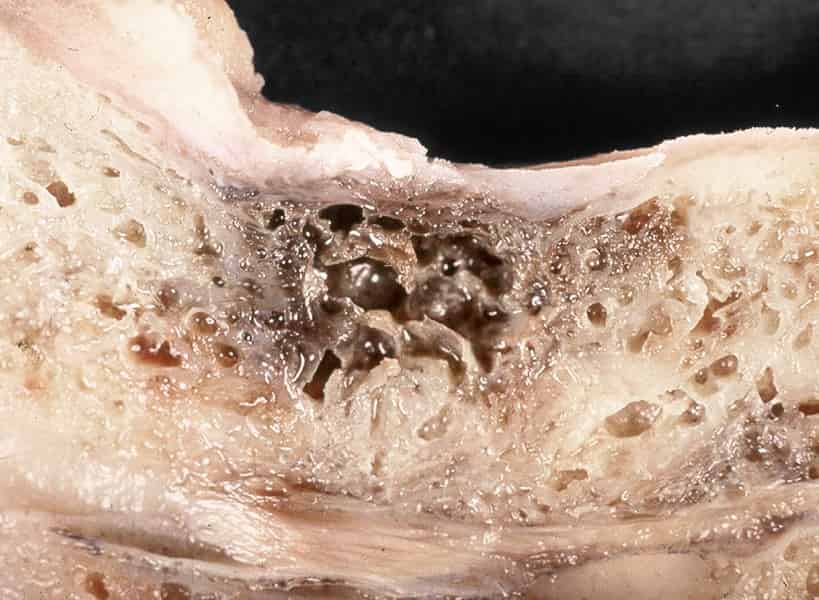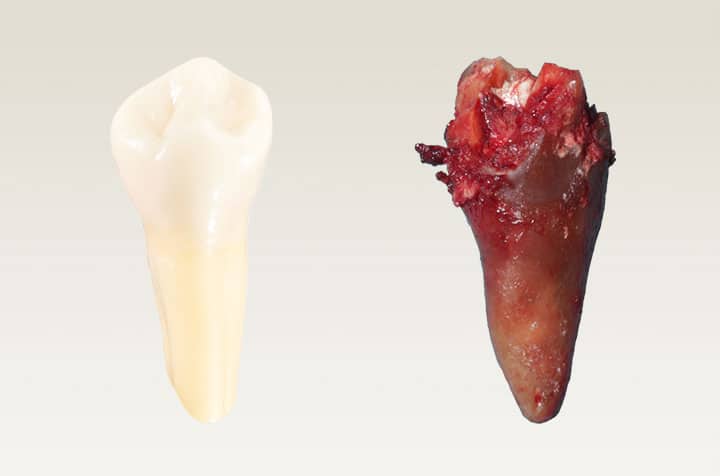Ogniska zapalne
Czym są ogniska zapalne
Koncept “ogniska zapalnego” zakłada, że choroba ogólnoustrojowa może być spowodowana przez mikroorganizmy i ich toksyczne produkty, które powstają w ognisku infekcji. Ognisko infekcji to miejsce, które może być zlokalizowane w każdej części ciała. Zawiera ono patogeny (mikroorganizmy) i zwykle jest asymptomatyczne. Rozprzestrzenienie się z ogniska infekcji patogenów i ich toksyn może powodować reakcję zlokalizowaną w innym obszarze ciała lub przyczyniać się do powstania opornych na leczenie dolegliwości przewlekłych.
Kawitacje (NICO)
Kawitacja (NICO – neuralgia-inducing cavitational osteonecrosis) to tłuszczowa martwicza zmiana w kości. Przyczyny powstania kawitacji to między innymi: nieprawidłowe gojenie po ekstrakcjach oraz obecność patogennych mikroorganizmów i ciał obcych w zębach i w kościach szczęk. Kawitacje mogą stanowić obciążenie dla organizmu i mogą uniemożliwić powrót do pełnego zdrowia.


Zęby martwe
Zęby leczone kanałowo są źródłem zapalenia, które może spowodować nie tylko problemy lokalne (w miejscu zapalenia) lecz często także w oddalonych częściach ciała. Ząb martwy, nie mając funkcjonującego połączenia z układem krwionośnym i limfatycznym, jest martwą tkanką organiczną a jego anatomia sprawia, że staje się perfekcyjnym siedliskiem patogennych mikroorganizmów. Patogenne mikroorganizmy osiedlają się sieci kanalikowej, generując wysoko toksyczne związki siarki (tioeter, merkaptan), które mogą blokować wiele procesów życiowych zachodzących w organizmie.

Leczenie
Leczenie kawitacji polega na pełnym, chirurgicznym usunięciu zmian martwiczych, a następnie dezynfekcji kości ozonem. Ozon niszczy komórki bakterii, grzybów i wirusów, nie niszcząc komórek ludzkich.
Badania i źródła do powyższego tekstu
Ogniska zapalne
- Dr. Elisabeth Jacobi-Gresser. Risiken für chronische Entzündungen durch orale Reizfaktoren: Immunlabordiagnostik in der Zahnheilkunde. ZMK Allgemeine Zahnheilkunde. 2012.
- Mieg R. Krankheitsherd Zähne: Wie sich kranke Zähne auf den ganzen Körper auswirken ; mit vielen eindrücklichen Fallbeispielen ; [Probleme erkennen – Hilfe finden]. 6th ed. Stuttgart: Trias; 2010. 144 Seiten.
- Voll R. Wechselbeziehungen von Odontonen und Tonsillen zu Organen, Störfeldern und Gewebssystemen. 5th ed. Uelzen: Med.-Literarische Verl.-Ges; 1996.
- Ganzimmun Diagnostics AG. Endotoxinämie: LPS im Serum als Marker für Silent Inflammation. 2015;(Fachinformation 0086):1-11.
Kawitacje
- Lechner J. Validation of dental X-ray by cytokine RAN- TES – comparison of X-ray findings with cytokine overex- pression in jawbone. Clin Cosmet Investig Dent. 2014;671–9. doi:10.2147/CCIDE.S69807
- Lechner J, Baehr V v. RANTES and fibroblast growth factor 2 in jawbone cavitations: triggers for systemic disease? Int J Gen Med. 2013;6277–90. doi:10.2147/IJGM.S43852
- Arend WP. The balance between IL-1 and IL-1Ra in disease. Cytokine Growth Factor Rev. 2002;13(4-5):323–40. doi:10.1016/s1359-6101(02)00020-5
- Lechner J, Bouquot JE, Baehr Vvv. Histologie und Immunologie der kavitätenbildenden Osteolysen des Kieferkno- chens: Orale und systematische Manifestation einer Maxillo-Mandibulären Osteoimmunologie ; pathomechanismen chronischer Entzündungserkrankungen. 1st ed. München: Selbstverl.; 2015. 320 Seiten. (Kavitätenbildende Osteolysen des Kieferknochens; vol. / J. Lechner ; 2).
- Bouquot JE, Roberts AM, Person P, Christian J. Neuralgia-inducing cavitational osteonecrosis (NICO). Osteomyelitis in 224 jawbone samples from patients with facial neu- ralgia. Oral Surg Oral Med Oral Pathol. 1992;73(3):307-19; discussion 319-20. doi:10.1016/0030-4220(92)90127-c
- Lechner J, Baehr V v. Chemokine RANTES/CCL5 as an unknown link between wound healing in the jawbone and systemic disease: is prediction and tailored treatments in the horizon? EPMA J. 2015;6(1):10. doi:10.1186/s13167-015- 0032-4
- Lechner J, Rudi T, Baehr V v. Osteoimmunology of tumor necrosis factor-alpha, IL-6, and RANTES/CCL5: a review of known and poorly understood inflammatory patterns in osteonecrosis. Clin Cosmet Investig Dent. 2018;10251–62. doi:10.2147/CCIDE.S184498
- Lechner J, Baehr V v. Hyperactivated Signaling Pathways of Chemokine RANTES/CCL5 in Osteopathies of Jawbone
- in Breast Cancer Patients-Case Report and Research. Breast Cancer (Auckl). 2014;889–96. doi:10.4137/BCBCR. S15119
- Azenshtein E, Luboshits G, Shina S, Neumark E, Shahbazian D, Weil M, Wigler N, Keydar I, Ben-Baruch A. The CC chemokine RANTES in breast carcinoma progression: regulation of expression and potential mechanisms of promalignant activity. Cancer Res. 2002;62(4):1093–102.
- Luettichau I v., Nelson PJ, Pattison JM, van de Rijn M, Huie P, Warnke R, Wiedermann CJ, Stahl RA, Sibley RK, Krensky AM. RANTES chemokine expression in diseased and normal human tissues. Cytokine. 1996;8(1):89–98. doi:10.1006/cyto.1996.0012
- Rentzos M, Nikolaou C, Rombos A, Boufidou F, Zoga M, Dimitrakopoulos A, Tsoutsou A, Vassilopoulos D. RANTES levels are elevated in serum and cerebrospinal fluid in patients with amyotrophic lateral sclerosis. Amyotroph Lateral Scler. 2007;8(5):283–7. doi:10.1080/17482960701419232
- Singh SK, Mishra MK, Eltoum I-EA, Bae S, Lillard JW, Singh R. CCR5/CCL5 axis interaction promotes migratory and invasiveness of pancreatic cancer cells. Sci Rep. 2018;8(1):1323. doi:10.1038/s41598-018-19643-0
- AnG,WuF,HuangS,FengL,BaiJ,GuS,ZhaoX.Effects of CCL5 on the biological behavior of breast cancer and the mechanisms of its interaction with tumor-associated macrophages. Oncol Rep. 2019;42(6):2499–511. doi:10.3892/ or.2019.7344
- Bischoff SC, Krieger M, Brunner T, Rot A, Tscharner V v., Baggiolini M, Dahinden CA. RANTES and related chemokines activate human basophil granulocytes through different G protein-coupled receptors. Eur J Immunol. 1993;23(3):761–7. doi:10.1002/eji.1830230329
Zęby martwe
- Jacobi-Gresser E, Schütt S, Huesker K, Baehr V v. Methyl mercaptan and hydrogen sulfide products stimulate proinflammatory cytokines in patients with necrotic pulp tissue and endodontically treated teeth. J Biol Regul Homeost Agents. 2015;29(1):73–84.
- Kwang S, Abbott P. The presence and distribution of bacteria in dentinal tubules of root filled teeth. Int Endod J. 2014;47(6):600–10. doi:10.1111/iej.12195
- Lechner J, Baehr V v. Impact of Endodontically Treated Teeth on Systemic Diseases. Dentistry. 2018;08(03). doi:10.4172/2161-1122.1000476
- Gomes C, Martinho FC, Barbosa DS, Antunes LS, Póvoa HCC, Baltus THL, Morelli NR, Vargas HO, Nunes SOV, Anderson G, Maes M. Increased Root Canal Endotoxin Levels are Associated with Chronic Apical Periodontitis, Increased Oxidative and Nitrosative Stress, Major Depression, Severity of Depression, and a Lowered Quality of Life. Molecular Neurobiology. 2018;55(4):2814–27. doi:10.1007/ s12035-017-0545-z
- Lechner J, Baehr V v. Stimulation of proinflammatory cytokines by volatile sulfur compounds in endodontically treated teeth. Int J Gen Med. 2015;8109–18. doi:10.2147/ IJGM.S77693
- Siqueira JF, Rôças IN, Alves FRF, Silva MG. Bacteria in the apical root canal of teeth with primary apical periodontitis. Oral Surg Oral Med Oral Pathol Oral Radiol Endod. 2009;107(5):721–6. doi:10.1016/j.tripleo.2009.01.042
- Vahlkamp T, Meijer AJ, Wilms J, Chamuleau RA. Inhibition of mitochondrial electron transfer in rats by ethanethiol and methanethiol. Clin Sci. 1979;56(2):147–56. doi:10.1042/ cs0560147
- IMD Berlin. Labordiagnostik bei chronisch entzündlichen Multisystemerkrankungen [Internet] . Available from: https://www.imd-berlin.de/fachinformationen/diagnostikinformationen/entzuendungsdiagnostik-bei-multisystemerkrankungen.html
- Richardson N, Mordan NJ, Figueiredo JAP, Ng Y-L, Gulabivala K. Microflora in teeth associated with apical periodontitis: a methodological observational study comparing two protocols and three microscopy techniques. Int Endod J. 2009;42(10):908–21. doi:10.1111/j.1365-2591.2009.01594.x
- Cotti E, Dessì C, Piras A, Flore G, Deidda M, Madeddu C, Zedda A, Longu G, Mercuro G. Association of endodontic infection with detection of an initial lesion to the cardiovascular system. Journal of Endodontics. 2011;37(12):1624–9. doi:10.1016/j.joen.2011.09.006
- Cotti E, Dessì C, Piras A, Mercuro G. Can a chronic dental infection be considered a cause of cardiovascular disease? A review of the literature. Int J Cardiol. 2011;148(1):4–10. doi:10.1016/j.ijcard.2010.08.011
- Bains R, Bains VK. Lesions of endodontic origin: An emerging risk factor for coronary heart diseases. Indian Heart J. 2018;70 Suppl 3S431-S434. doi:10.1016/j. ihj.2018.07.004
- Ganzimmun Diagnostics AG. Endotoxinämie: LPS im Serum als Marker für Silent Inflammation. 2015;(Fachinformation 0086):1-11.
- Dr. Elisabeth Jacobi-Gresser. Risiken für chronische Entzündungen durch orale Reizfaktoren: Immunlabordiagnostik in der Zahnheilkunde. ZMK Allgemeine Zahnheilkunde. 2012.
- Aminoshariae A, Kulild JC, Mickel A, Fouad AF. Association between Systemic Diseases and Endodontic Outcome: A Systematic Review. Journal of Endodontics. 2017;43(4):514–9. doi:10.1016/j.joen.2016.11.008
- Murray CA, Saunders WP. Root canal treatment and general health: a review of the literature. Int Endod J. 2000;33(1):1–18. doi:10.1046/j.1365-2591.2000.00293.x
- Liljestrand JM, Mäntylä P, Paju S, Buhlin K, Kopra KAE, Persson GR, Hernandez M, Nieminen MS, Sinisalo J, Tjäderhane L, Pussinen PJ. Association of Endodontic Lesions with Coronary Artery Disease. J Dent Res. 2016;95(12):1358– 65. doi:10.1177/0022034516660509
- Segura-Egea JJ, Martín-González J, Castellanos-Cosano L. Endodontic medicine: connections between apical periodontitis and systemic diseases. Int Endod J. 2015;48(10):933–51. doi:10.1111/iej.12507
- Goon ATJ, Isaksson MAI. Hand Eczema from Acrylate Compounds in Dentistry. In: Alikhan A, Lachapelle J-M, Maibach HI, editors. Textbook of Hand Eczema. Berlin, Heidelberg: Springer Berlin Heidelberg; 2014. p. 169–83. (vol. 34).
- Mjör IA, Nordahl I. The density and branching of dentinal tubules in human teeth. Archives of Oral Biology. 1996;41(5):401–12. doi:10.1016/0003-9969(96)00008-8
- Merkur.de. Diese Viren und Bakterien machen uns krank: Sie sind unsichtbar, aber überall: Viren und Bakterien machen uns krank. Doch die beiden Erreger haben sonst wenig gemeinsam. Warum sie sich unterscheiden. [Internet]. 2017. Available from: https://www.merkur.de/leben/ gesundheit/viren-bakterien-sind-menschen-gefaeh-
- rlich-virusinfektion-zr-4417390.html
- Dr. Elisabeth Jacobi-Gresser. Risiken für chronische Entzündungen durch orale Reizfaktoren: Immunlabordiagnostik in der Zahnheilkunde. ZMK Allgemeine Zahn- heilkunde. 2012.
- CaiX,CaoC,LiJ,ChenF,ZhangS,LiuB,ZhangW, Zhang X, Ye L. Inflammatory factor TNF-α promotes the growth of breast cancer via the positive feedback loop of TNFR1/NF-κB (and/or p38)/p-STAT3/HBXIP/TNFR1. Oncotarget. 2017;8(35):58338–52. doi:10.18632/oncotarget.16873
- Wolczyk D, Zaremba-Czogalla M, Hryniewicz-Jankowska A, Tabola R, Grabowski K, Sikorski AF, Augoff K. TNF-α promotes breast cancer cell migration and enhances the concentration of membrane-associated proteases in lipid rafts. Cell Oncol (Dordr). 2016;39(4):353–63. doi:10.1007/ s13402-016-0280-x